
* In the early 1960s, the US Navy introduced a carrier-based airborne early warning (AEW) aircraft, the "E-2 Hawkeye", fitted with radar to help protect naval formations and support naval activities. The Hawkeye, after many improvements, remains an important military asset in the 21st century. This document provides a history and description of the Hawkeye. A list of illustration credits is included at the end.
* Grumman Corporation, now part of Northrop Grumman, was a pioneer in airborne early warning (AEW) technology, adapting the Grumman Avenger torpedo-bomber to the AEW role under Project CADILLAC at the end of World War II. In 1955, the Navy Bureau of Aeronautics (BuAer) issued a request for an advanced carrier-based AEW aircraft. However, BuAer officials realized that the spec was so advanced that the new aircraft wouldn't be ready until into the 1960s, and so the BuAer also ordered two prototypes of a much simpler AEW derivative of the proven Grumman S2F ("Stoof") Tracker antisubmarine warfare (ASW) aircraft as an "interim solution".
The result was the Grumman "WF-2 Tracer", relabeled "E-1B" when the US military converted to a common aircraft designation scheme in 1962. The "Stoof With A Roof" -- or "Willie Fudd", as it was known due to its "WF" designation -- was a capable machine, with a state-of-the-art AN/APS-82 radar and analogue tactical datalinks, and it would remain in service well into the 1970s despite its "interim nature".
However, "state of the art" in the 1950s was not all that sophisticated, and the Navy was still determined to press on to the advanced solution. After consideration of proposals, Grumman's "Model 123" was selected as the winner of the requirement in March 1957 as the "W2F-1" -- to later become the "E-2A Hawkeye". It was the first aircraft ever built from the ground up as an AEW platform.
Initial flight of the first of three prototypes was on 21 October 1960, though at the outset the aircraft was basically a raw airframe, with little in the way of vital operational avionics systems. The first flight of a prototype with what could be regarded as a full configuration was on 19 April 1961.
* As it emerged, the Hawkeye had a clear evolutionary relationship to the interim Willie Fudd, and in fact early on it was sometimes called the "Super Fudd". Both machines had high-mounted wings that folded back along the fuselage in classic Grumman fashion; twin engines; a radome on the back; tricycle landing gear and a yoke arresting hook; and a four-fin tail, with the multiple tailfins providing adequate tailfin area while permitting clearance in the hangar deck of smaller fleet carriers.
However, the Hawkeye was clearly a different aircraft from the Willie Fudd. In particular, instead of the Cyclone radial piston engines of the WF-1, the Hawkeye used twin Allison T56-A-8/8A turboprops providing 3,020 kW (4,050 SHP) each -- the T56 also being used on the Lockheed P-3 Orion ASW aircraft and the Lockheed C-130 Hercules cargolifter -- driving four-bladed Aeroproducts paddle propellers. The main engine intake was below the prop, with an oil cooler intake below the main intake. The Hawkeye featured an advanced (for the era) General Electric (GE) AN/APS-96 radar system, with the antenna installed in a distinctive new saucer-shaped rotating radome with a diameter of 7.31 meters (24 feet). The Willie Fudd had carried a rotating antenna array inside a fixed radome.
In more detail, the Hawkeye featured wings that hydraulically folded back in classic Grumman style along the fuselage, from a wing break just outboard of the turboprops. The wings featured ailerons and flaps, with the ailerons drooping automatically when the flaps were lowered, while the tailplane had an 11-degree dihedral. All control surfaces were hydraulically boosted, and all flight surfaces featured pneumatic de-icing boots on the leading edge that "pulsed" to break ice off the leading edges of the wings.
Given the configuration of the aircraft, with some suggestion of a boomerang, it wasn't surprising that it was subject to yaw instability, one pilot comparing it to "like riding a bicycle with loose handlebars", requiring a certain adroitness when any change was made in its flight. The engines were also not "handed", the props both spinning in the same direction to simplify maintenance, and so any throttle changes required some application of rudder.
The aircraft had tricycle landing gear. The steerable nose gear had two wheels and an attachment for catapult launch. Each main gear had a single wheel, with the gear retracting forward into the engine nacelle, the wheel turning 90 degrees to lie flat. There was a retractable tailskid just behind the yoke arresting hook to protect the aircraft's tail on take-off, and a cooling system pack on the top of the fuselage to help keep the electronics gear working.
The flight crew included a pilot and copilot, plus three electronics systems officers (ESO) or "ravens", all in pressurized accommodations. The crew got into and out of the aircraft through a hinge-down door with integral steps on the middle left side of the fuselage. The ESO section was called the "Combat Information Center (CIC)" and had a toilet in the rear. There was an access corridor between the cockpit and the CIC.
The CIC had three consoles, facing left. The CIC was run by a "CIC Officer (CICO)", who was essentially the mission commander -- the pilot and copilot being responsible only for flying the aircraft. The other two operators were the "Radar Operator (RO)", who in principle was to supervise the radar system, and the "Air Control Officer (ACO)", who in principle was to supervise air communications. Each sat at a workstation with a classic round radarscope. In practice, the three all operated in the radar observation and air control role, if under a rank hierarchy, with the specializations of the different roles becoming less prominent as Hawkeye system automation improved.
The radar "rotodome" could be lowered 61 centimeters (2 feet) after landing to permit clearance on the hangar deck. In flight, the rotodome was set at a positive angle of incidence to provide enough lift to handle its own weight. It rotated at a rate of 6 revolutions per minute (RPM). The AN/APS-96 radar operated in the UHF band, around a wavelength of roughly a meter, and could observe sea and sky over a radius of 370 kilometers (200 NMI) from the aircraft's operational altitude of 9,150 meters (30,000 feet).
Despite the fact that UHF means "ultra-high frequency", the band is relatively low frequency by radar standards. UHF was chosen because it was more indifferent to sea clutter, was less affected by weather, and made small targets look big; all future Hawkeye variants would retain use of UHF. The AN/APS-96 was innovative in that it provided automatic target tracking: in earlier AEW aircraft, the radar operator had to observe target blips and figure out the target track and speed on his own. The AN/APS-96 was one of the major components of the E-2A's "Airborne Tactical Data System (ATDS)", which linked the radar with a primitive computer system based on a magnetic-drum mass storage, datalinks, and an identification friend or foe (IFF) system. The IFF antenna was mounted on the back of the radar antenna, meaning that the radar scan alternated with IFF interrogation during each sweep. The E-2A also had a set of radios.
* Deliveries of the E-2A to the Navy began in 1964, with a total of 59 production machines handed over. Although sources generally tend to give the impression that the Hawkeye was as an overnight success, in fact the E-2A didn't meet spec; it was regarded as so unsatisfactory that production was halted in early 1965. The problem was partly excessive ambition, the 1950s being an era of attempts to build futuristic technologies that seemed far more achievable than they actually were. The E-2A's avionics systems were highly capable when they worked, but they were unreliable to the point of uselessness, the rotary-drum mission computer system being a particular weak point. The airframe was also prone to corrosion -- a ghastly fault in a carrier-based aircraft. The entire Hawkeye fleet was grounded at one time.
Grumman and the Navy scrambled to implement fixes, the result being the "E-2B", which featured a modernized avionics system built around a Litton L-304 digital computer and some other fixes. The first E-2B performed its initial flight on 20 February 1969. 49 of the E-2As were updated to the E-2B spec to 1971 -- with four others converted to "TE-2A" pilot trainers, and a number of others being used for test and trials. However, the E-2B was strictly an interim fix. The Navy had initiated a "pre-planned product improvement (P3I)" program in 1968 to give the Hawkeye a thorough workover, which would emerge as the definitive "E-2C".
BACK_TO_TOP* Groundwork for the E-2C was laid by trials of the improved GE AN/APS-111 radar on an E-2A from 1965 to 1967, which led to the production AN/APS-120 radar. The AN/APS-120 featured an "airborne moving target indicator (AMTI)" capability that gave it a limited ability to spot moving targets on land. Two E-2A test machines were modified as prototypes of the E-2C, with the first flying on 20 January 1971. Trials proving satisfactory, the E-2C was ordered into production, with the first production machine performing its initial flight on 23 September 1972. The E-2C entered fleet service in November 1973.
Along with the improved AN/APS-120 radar, the E-2C also featured:
Along with the longer nose, the E-2C also featured a much larger cooling pack on top of the fuselage behind the cockpit to deal with the more formidable operational avionics system.
___________________________________________________________________
GRUMMAN E-2C HAWKEYE:
___________________________________________________________________
wingspan:
24.6 meters (80 feet 7 inches)
width, wings folded:
8.94 meters (29 feet 4 inches)
wing area:
65.03 sq_meters (700 sq_feet)
length:
17.5 meters (57 feet 7 inches)
height:
5.58 meters (18 feet 4 inches)
empty weight:
17,300 kilograms (38,100 pounds)
max loaded weight:
23,600 kilograms (52,000 pounds)
maximum speed:
600 KPH (375 MPH / 325 KT)
service ceiling:
9,390 meters (40,000 feet)
ferry range:
2,580 kilometers (1,600 MI / 1,390 NMI)
patrol endurance:
> 4 hours
___________________________________________________________________
After overcoming some initial skepticism, the E-2C proved to be the machine the Hawkeye was supposed to have been all along. Hawkeyes were fitted from 1976 with the improved AN/APS-125 radar that provided Doppler processing and the ability to track land targets in an automated fashion.
* These "Basic Charlie" machines were then more comprehensively upgraded from 1980 to what would later be known as the "Group 0" configuration, which featured:
* A total of 55 Basic Charlies / Group 0 Hawkeyes was delivered to the USN up to 1988. After the trials of the E-2A/B, the E-2C proved an outstanding aircraft in service. It was actually powerful and surprisingly agile, even establishing some performance records in its class, though its short fuselage -- designed to the hangar-deck constraints of smaller carriers -- meant that it could be a handful on single-engine handling. The spinning radome also was a bit of a surprise to novice pilots, since it set up torque that would skew the aircraft off course unless compensated for by engine trimming. Landing was somewhat tricky since the span was wide and the aircraft had to be put down precisely on the carrier-deck centerline. Its deck handling was regarded as very good. Mission endurance was over four hours and the aircraft could be turned around in about 15 minutes, taking off again with a fresh crew.
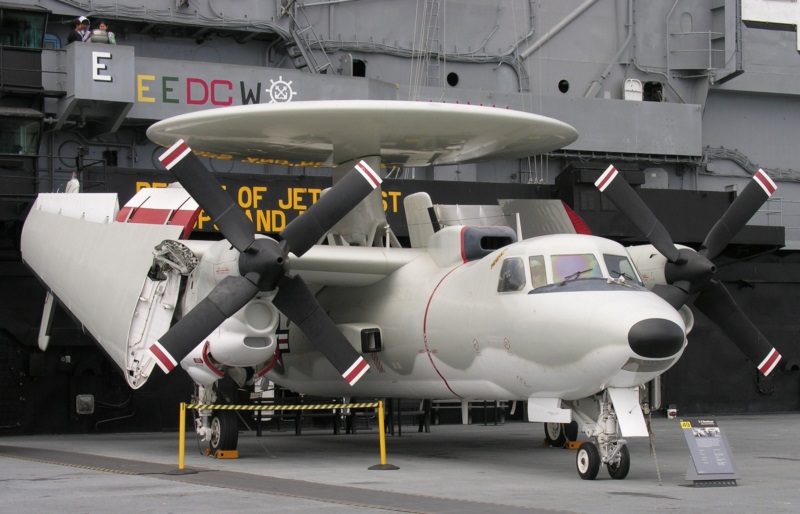
The E-2C was usually called the "Hummer" because of the smooth, resonant sound of its twin T56 engines. The Hawkeye provided an effective partner to Grumman F-14 Tomcat fighters, monitoring the airspace around a carrier group or battle area and then vectoring Tomcats over the Link-4 datalink to destroy intruders with long-range Phoenix air-to-air missiles. The Hawkeye's baptism of fire with the US Navy was in the Operation EL DORADO CANYON strikes against Libya in 1986, and it went to serve in all the major conflicts that the Navy has been involved in since. The E-2C also proved useful in air refueling support, in search and rescue operations, and on a few occasions as a flying air traffic control center for relief operations.
BACK_TO_TOP* The Group 0 Hawkeye wasn't the end of the E-2C line by any means, since production continued with the "Group 1", which featured:
18 Group 1 machines were built. There was thought of upgrading the old Group 0 machines to the same spec, but once a service-life extension program was factored in the upgrade was about as expensive as a new-build aircraft, and it didn't happen. Group 0 Hawkeyes were gradually phased out of first-line service, though apparently some ended up in Navy Reserve hands, being used to track drug smugglers trying to fly in over America's southern borders.
* The Group 1 Hawkeyes were actually an interim step to the much more ambitious "Group 2" Hawkeye, which was introduced into service in 1992. The step ahead was so dramatic that aircrews described it as "nothing less than fantastic." The Group 2 Hawkeye featured:
A total of 12 Group 1 Hawkeyes was brought up to Group 2 standards. Since production of the Hawkeye is ongoing, it is difficult to know how many more Hawkeyes have been built, but in 1999 the US Navy Hawkeye fleet numbered 89 aircraft. At least five of the aircraft were stripped of operational avionics and used for pilot training under the designation of "TE-2C".
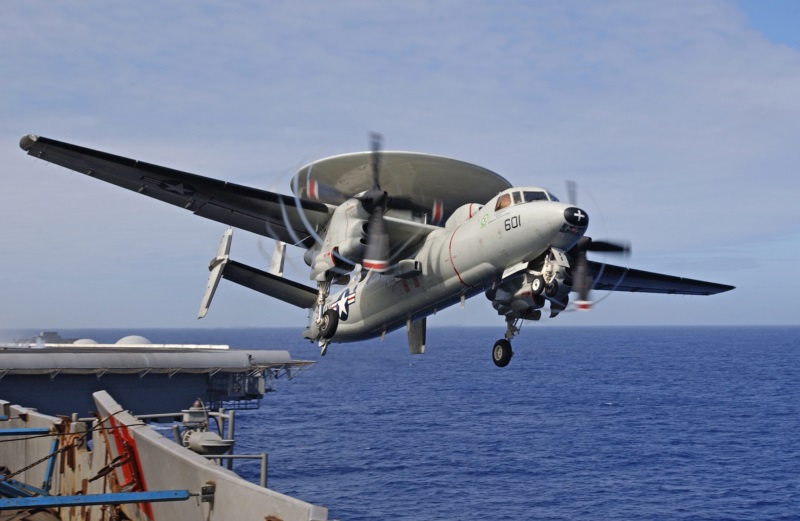
* A "Group 2 Plus" configuration was introduced in the mid-1990s, featuring:
The Group 2 Plus upgrades led to the next level of upgrade, known as the "Hawkeye 2000", which included:
The AN/APS-145 radar was retained. The various Group 2 Plus / Hawkeye 2000 upgrades were installed in a phased fashion, meaning the configuration of the Hawkeyes being upgraded was a continuously moving target. The first Hawkeye 2000 machine was redelivered in 2001, with 24 machines updated in total.
BACK_TO_TOP* There have been a number of foreign users of the E-2C. Israel was the first, buying four "Basic Charlie" machines in 1977:1978. The Israelis called the type the "Daya (Kite)", and were apparently the first to use the E-2C in combat, with E-2Cs supervising the entirely one-sided 1982 Israeli Air Force "Turkey Shoot" against Syrian fighters in the skies over the Bekaa Valley in Lebanon.
The Israeli E-2Cs were mothballed in 1994, the Israelis having moved on to their own AEW platforms, based on the Phalcon radar system. One of the three Dayas ended up as a museum display, while the other three were refurbished by Israel Aircraft Industries and sold to the Mexican Navy, with deliveries in 2004. The other buyers included:
* Even as the Hawkeye 2000 was being delivered to the fleet, the Navy was looking towards the next generation. The result is the "E-2D Advanced Hawkeye". It looked much like previous variants, but was generally updated under the skin. Many aircraft assemblies were replaced by more modern assemblies made of improved materials, with an emphasis on large one-piece machined parts that reduce weight and easy assembly. Maximum carrier landing weight was increased. Most significantly, the E-2D carried a substantially improved AN/APY-9 radar, integrated into a completely modernized operational avionics system.
The AN/APY-9 was a "hybrid" radar, with the antenna rotating to scan the sky, but featuring a high-resolution passive phased array / electronically steered subsystem to focus on specific targets. The AN/APY-9 had improved processing and greater sensitivity, allowing it to observe a volume of airspace three times greater than that of the E-2C's AN/APS-145 radar. One of its significant new features was "space-time adaptive processing (STAP)" software that allowed the radar to alter its operation as required by circumstances, giving it the ability to pick up targets in rough terrain and urban sprawl -- reflecting the more varied operational environments faced by the US Navy in the 21st century. The radome also included an IFF antenna, and was complemented by an advanced digital ESM and an infrared imager, with the operational avionics system performing "sensor fusion" to produce a single annotated "map" of the airspace environment.
The operational avionics system featured a new glass cockpit, and three workstations with three 43-centimeter (17-inch) color flat-panel displays. Although the E-2D leveraged heavily off of Hawkeye 2000 software, about two million lines of code were added, providing much greater integration of the pilot, copilot, and three systems operators -- for example, the pilot or copilot could see a workstation display on a cockpit display with the flick of a switch. The improved integration allowed the pilot or copilot to lend a hand as a systems operator.
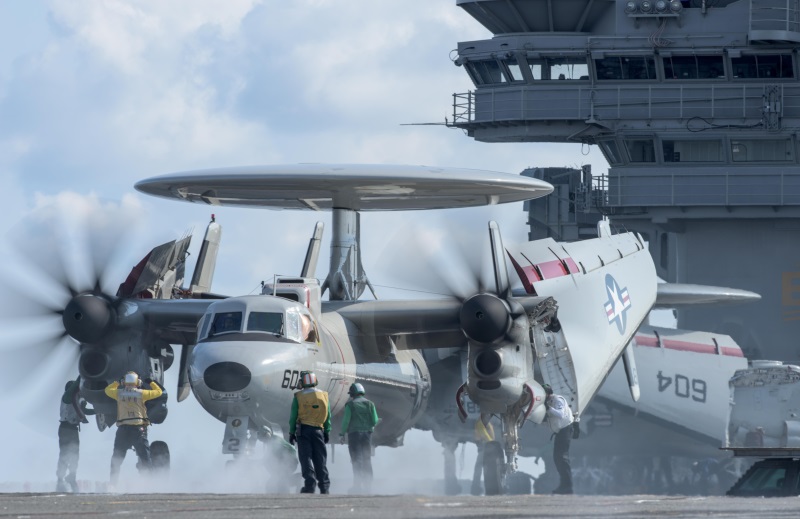
The E-2D also featured "Tactical Targeting Networking Technology" datalink system to share data with or provide direction to other Navy sea and air assets. One pilot said there was no comparison between the Hawkeye "Charlie" and the "Delta":
BEGIN_QUOTE:
The E-2D is an awesome aircraft. It may look like an E-2C from the outside, but once you are inside, it is non-recognizable to anyone who has flight time in the Charlie ... it is leaps and bounds ahead of the [Charlie's] technology ...
END_QUOTE
The E-2D was fitted with uprated Rolls-Royce T56-A-427 engines, driving the 8-blade composite propellers, to deal with higher take-off weight. System upgrades are already in planning, such as an improved CEC capability and a capability to intrude into adversary radio communications networks. Regular software updates are scheduled, for example to add improved target identification, more systems automation, and improved datalink access -- with one goal being to ultimately permit remote operators at ground or shipboard stations to act as additional E-2D crew members. The E-2D was also designed with an "open architecture" to permit relatively easy upgrades of hardware.
Full-scale development of the E-2D began in 2003, with initial flight of the first of two prototypes in August 2007. Initial delivery of the E-2D to the Navy was in 2010 for operational evaluation, with introduction to service in 2014. The Navy plans to acquire 75 E-2Ds, replacing the E-2C by 2025. Japan is in the process of obtaining 18 E-2Ds, as a follow-on to Japan's E-2Cs, with initial delivery in late 2019; the French are similarly planning to buy three E-2Ds, with delivery in 2027 and 2028. Taiwan is talking about updating their E-2Ks to E-2D spec, while the E-2D has been offered to India.
The E-2D fleet is being upgraded with a mid-air refueling capability; an E-2C and E-2D were fitted with a probe as a test. New-build E-2Ds are now being produced with the probe, with the first being redelivered in late 2019, band older machines will be upgraded with it. There is also interest in adding a fuel tank inside the wing outboard of the wing fold to increase endurance. Software updates are ongoing.
Other upgrades in the works include:
Improved seats and other crew comforts are being considered. The Japanese stipulated a microwave oven and toilet for their E-2Ds; it is possible they will be added to US Navy E-2Ds as well. The Hawkeye is likely to keep flying into the 2040s.
BACK_TO_TOP* The Hawkeye's sister design, the "C-2A Greyhound Carrier Onboard Delivery (COD)" aircraft, was designed as a cargo and personnel transport capable of carrier take-offs and landings. The C-2A was based on the Hawkeye but featured a largely redesigned fuselage for cargo carriage, with greater fuel capacity and strengthened nose gear to handle higher weights. The tail assembly was also redesigned, since it did not have to compensate for the aerodynamic interference of the Hawkeye's radome, and lacks the dihedral of the Hawkeye's tail assembly.
The Greyhound was developed roughly in parallel with the Hawkeye, with two flight prototypes and a single static-test airframe built. The first prototype performed its initial flight on 18 November 1964. Initial deliveries to the fleet were in 1966.
Like the Hawkeye, the Greyhound was initially powered by twin Allison T56-A-8 turboprop engines, with improved engine variants refitted in time, and featured the traditional Grumman side-folding wing scheme. An auxiliary power unit allowed engine starting and ground operation at remote locations where ground support facilities were lacking. The C-2A had a crew of four, and was fitted with an extensive avionics suite, including radios, navigation gear, and carrier landing systems. The Greyhound could carry 4,535 kilograms (10,000 pounds) of cargo, or 39 passengers, or 20 litters with four attendants. If operating off land bases instead of a carrier deck, it could carry up to 6,800 kilograms (15,000 pounds) of cargo. It was also capable of performing "search and rescue (SAR)" duties as a secondary mission.
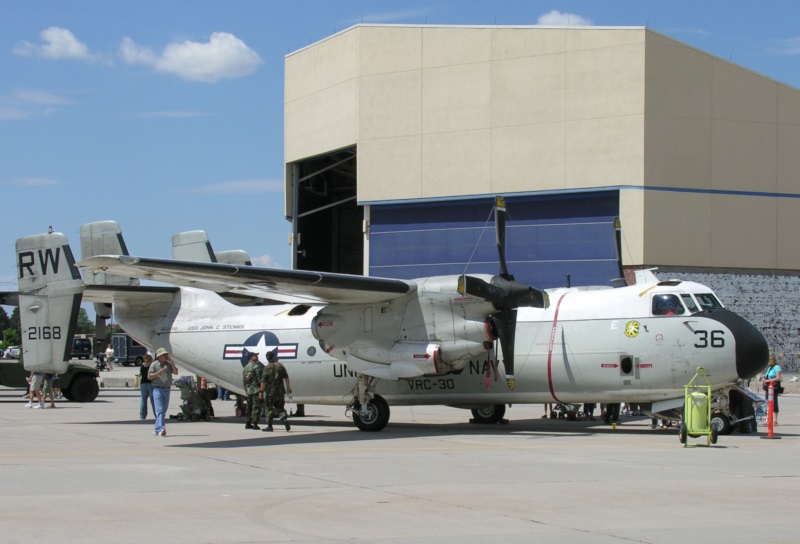
Cargo was loaded though an aft cargo door with an integral ramp, moved into place with an overhead powered winch system in the cargo bay, and lashed down using a cage system. The rear cargo door could be opened in flight for airdrop of supplies. Ferry tanks could be fitted in the cargo hold, and apparently there was provision for an external tank or buddy refueling pod on each side of the fuselage.
___________________________________________________________________
GRUMMAN C-2A GREYHOUND:
___________________________________________________________________
wingspan:
24.56 meters (80 feet 7 inches)
width, wings folded:
8.94 meters (29 feet 4 inches)
length:
17.32 meters (57 feet 10 inches)
height:
4.84 meters (15 feet 11 inches)
empty weight:
16,485 kilograms (36,346 pounds)
loaded weight:
26,080 kilograms (57,500 pounds)
max speed at altitude:
575 KPH (360 MPH / 310 KT)
cruise speed:
480 KPH (300 MPH / 260 KT)
service ceiling:
10,200 meters (33,500 feet)
range:
1,930 kilometers (1,200 MI / 1,040 NMI)
___________________________________________________________________
Only 19 Greyhounds went into service from 1965 to 1968, plans for acquisition of a dozen more having been canceled. All these initial-build aircraft were put through a "service life extension program (SLEP)" beginning in 1973 to keep them in operation.
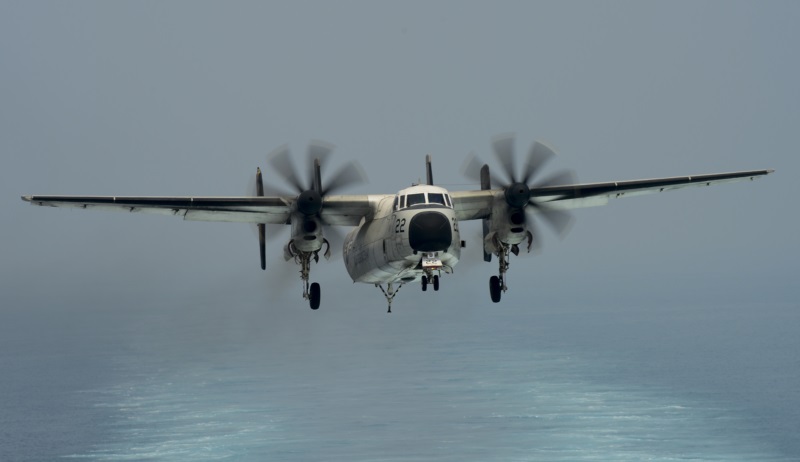
In 1984, the Navy awarded a contract to Grumman for 39 new "C-2A(R)" aircraft, where the "R" stood for "Reprocured", with the first going into service in 1985. These aircraft featured airframe reinforcement and avionics improvements over the original C-2As, which were all phased out by 1987. The Navy has performed some additional updates on the C-2A(R) -- a new SLEP, avionics upgrades (including the CAINS II system), and the NP2000 eight-blade propellers.
However, the Greyhound's days are numbered, with the Navy now replacing it with a COD version of the Marines' Bell-Boeing MV-22B Osprey tiltrotor, the "CMV-22B", with additional fuel tanks for extended range. The USMC had pushed to obtain the CMV-22B to extend the "footprint" of the Marine Osprey fleet. Initial deliveries of the CMV-22B began in 2020, with the Greyhound to be out of service by 2026.
BACK_TO_TOP* In the late 1980s, the US Coast Guard (USCG) briefly operated four E-2Cs on loan from the Navy to hunt for drug smugglers. USCG brass were impressed with the Hawkeye and wanted to acquire their own fleet of AEW aircraft. Since longer endurance was needed, the concept solidified as a modification of a Lockheed HC-130H Hercules transport, which was operated by the Coast Guard, fitted with AN/APS-145 radar and a subset of the associated Hawkeye operational avionics.
General Dynamics performed the conversion, with the aircraft performing its initial flight as the "EC-130V" on 31 July 1991. The system, nicknamed the "Herkeye", apparently worked as per specification, but it proved too expensive and there was no follow-through on the program. The EC-130V was passed on to the US Air Force in 1993 for test and trials use.
* The US Customs Service -- now the Customs & Border Protection Service -- also became interested in an AEW system based on Hawkeye avionics, resulting in mating the E-2C radar system to surplus Lockheed P-3 Orion maritime patrol aircraft airframes. The first of these "P3 AEW" machines performed its maiden flight on 8 April 1988. It was fitted with AN/APG-125 radar initially, but later updated to AN/APG-138 radar. Three more were delivered to 1993, with another batch of four delivered beginning in the late 1990s.
All the later machines were delivered with AN/APG-138 radar; the entire fleet of eight was then updated with AN/APG-145 radar. Customs also obtained eight P-3 Orions as "Long Range Trackers (LRT)", featuring a sensor suite but no AEW system and radome. The P-3 AEW and P-3 LRT often operate in teams. Customs P-3 machines were put through a SLEP from 2008 to keep them in service.
* Sources include:
* Illustrations credits:
* Revision history:
v1.0.0 / 01 jun 07 v1.0.1 / 01 apr 09 / E-2D first flight. v1.0.2 / 01 mar 11 / Review & polish. v1.0.3 / 01 feb 13 / Update on Customs P-3 machines. v1.0.4 / 01 jan 15 / Notes on flight handling. v1.0.5 / 01 dec 16 / CMV-22B. v1.0.6 / 01 nov 18 / Review & polish. v1.0.7 / 01 oct 20 / Illustrations update v1.1.0 / 01 aug 22 / Review & polish. v1.1.1 / 01 sep 22 / Minor update. v1.1.2 / 01 jun 24 / Review, polish, & update. (+)BACK_TO_TOP
